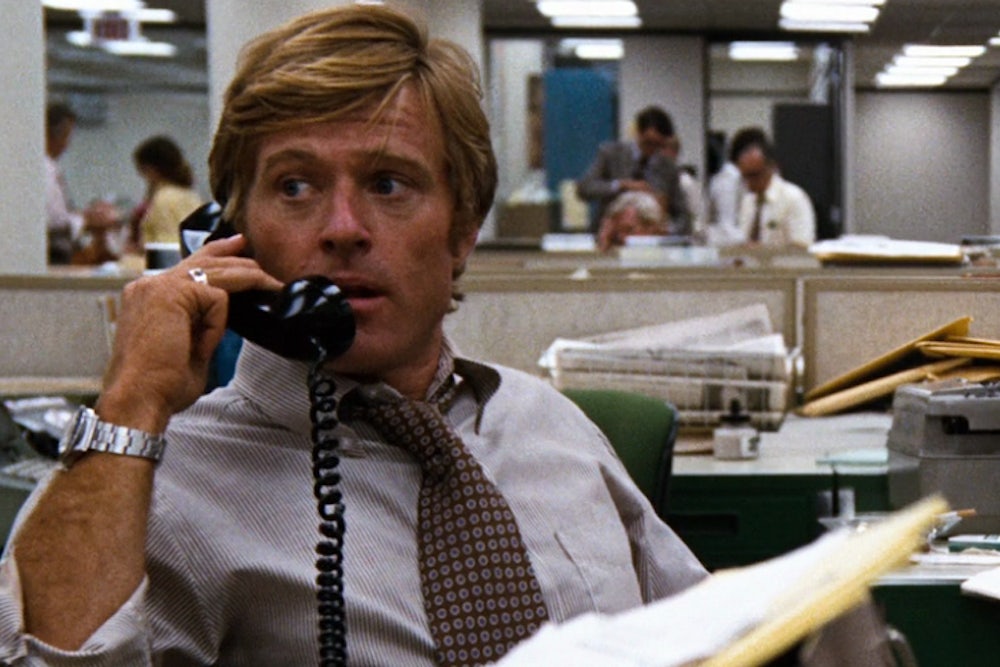The news that the Washington Post is looking to sell its 15th Street headquarters, where it’s resided since 1950, makes me very sad, because my first job in journalism was in that newsroom. Or rather, an ersatz version of that newsroom. Perhaps I should explain.
In June 1972, some burglars broke into the offices of the Democratic National Committee. Nobody thought much of the story except at the Post, where two young reporters, Bob Woodward and Carl Bernstein, kept after it and kept after it until President Richard Nixon had to resign. Woodward and Bernstein wrote up their exploits in a book called All The President’s Men, and in 1975 the film director Alan J. Pakula turned that book into a movie. Three thousand miles from the Post building, Pakula meticulously recreated the Post newsroom on a Warner Brothers sound stage, right down to 37 boxes worth of newsroom paper trash.
“Nearly 200 desks at $500 apiece were purchased from the same firm that sold desks to The Post four years ago,” a Post feature reported, “and to color them just right, the same precise shades of paint—be they ‘6 ½ PA Blue’ or ‘22 PE Green’—are being mixed on special order.”
Even more than the book (which was a best-seller), the film of All The President’s Men turned the Post newsroom into a kind of unofficial national landmark. Whenever I show visitors around Washington, they want to see the building where Robert Redford and Dustin Hoffman brought down a corrupt president. Nobody would mistake it for an architectural gem like the Tribune Tower in Chicago, the old New York Times building, the old Philadelphia Inquirer building, or the wonderfully gaudy, Moorish headquarters of the Los Angeles Herald-Examiner. The interest in the Post building is more historical than aesthetic, more about interiors than the exterior. It’s about that famous newsroom. And because the newspaper business is nowhere near as robust economically as it was in the 1970s, a lot of newspaper headquarters have gotten sold off. The Times building was vacated in 2007, the Inquirer building was sold in 2011, and the Herald-Examiner building has stood spookily vacant since the Hearst Corporation shut down the paper in 1989.
Like the mythology spawned by the movie, the props on that California sound stage lived on. After shooting was completed on All The President’s Men, Warner Brothers had all that furniture to get rid of. (It was far too ugly to repurpose for Warners’ own studio offices.) Meanwhile, New York magazine editor Clay Felker was starting up a west coast sister publication to New York magazine called New West. The feng shui of outfitting New West’s Beverly Hills headquarters with the furniture used to glamorize the Washington Post’s proudest moment proved irresistible to Felker. In an expansive mood (he had also just purchased the Village Voice), Felker bought the whole batch from Warners. By the time I arrived as a summer intern in 1977, Rupert Murdoch had successfully completed a hostile takeover of Felker’s New York Magazine Company, including New West—an early hint that bleak times lay ahead for the news business. But the fake Post furniture was still in New West’s office on Wilshire Boulevard, albeit modified by the drilling of holes through several desktops to allow for the insertion of Cinzano umbrellas (a fashion statement unthinkable in the real Post newsroom).
This was where my journalism career began: In a Washington Post newsroom fueled by righteous moral fervor and then re-imagined by Hollywood. No wonder I couldn’t resist!
My subsequent labors for the actual Washington Post Company tracked the news industry’s post-seventies decline. In the late 1980s I worked at Newsweek, a sort of a canary in the coal mine, already slouching toward oblivion well ahead of the still-thriving big city newspapers (including the Post). In the aughts I worked at Slate, a much happier and more creative place. Eventually, though, the more senior staff (including me) had to be let go for roughly the same economic reasons that now have the Post Company scouting cheaper real estate. Neither job located me at the Post’s storied 15th Street address, and through the years I’ve spent only a little time hanging out in the Post newsroom. Still, whenever I’ve stopped by I’ve felt a sentimental affinity for the place that’s traceable, I think, to my hungry-intern days haunting the fake Washington Post.
Fifteen years after my New West internship—with New West and its successor publication, California magazine, long gone—I was working as a Washington-based reporter at the Wall Street Journal when Pakula once again decided to make a movie set largely inside a newsroom. The movie this time was an adaptation of John Grisham’s The Pelican Brief. Because he’d already recreated the Post, Pakula decided to model his (in this instance, entirely fictional) newsroom on the Journal’s Washington bureau. Once again, assistants were sent in to figure out what a Washington newsroom was supposed to look like. As far as I know no effort was made to create replicas of our desks, but we were alerted that our paper trash would be collected, shipped to Hollywood, and festooned across a sound studio. The Pelican Brief was nowhere near as good as All The President’s Men, and the fake Journal Washington bureau was no match for the fake Post newsroom, even knowing the trash spread across Denzel Washington’s desk might be my own.
But at least the real Journal newsroom that I knew and loved in Washington still stands on Connecticut Ave. Murdoch’s got his mitts on it now, but he hasn’t sold it. Not yet, anyway.
This article has been corrected. It originally stated that John Grisham was responsible for choosing the design for the newsroom that appeared in the Pelican Brief. In fact, it was Alan Pakula who made the choice.
